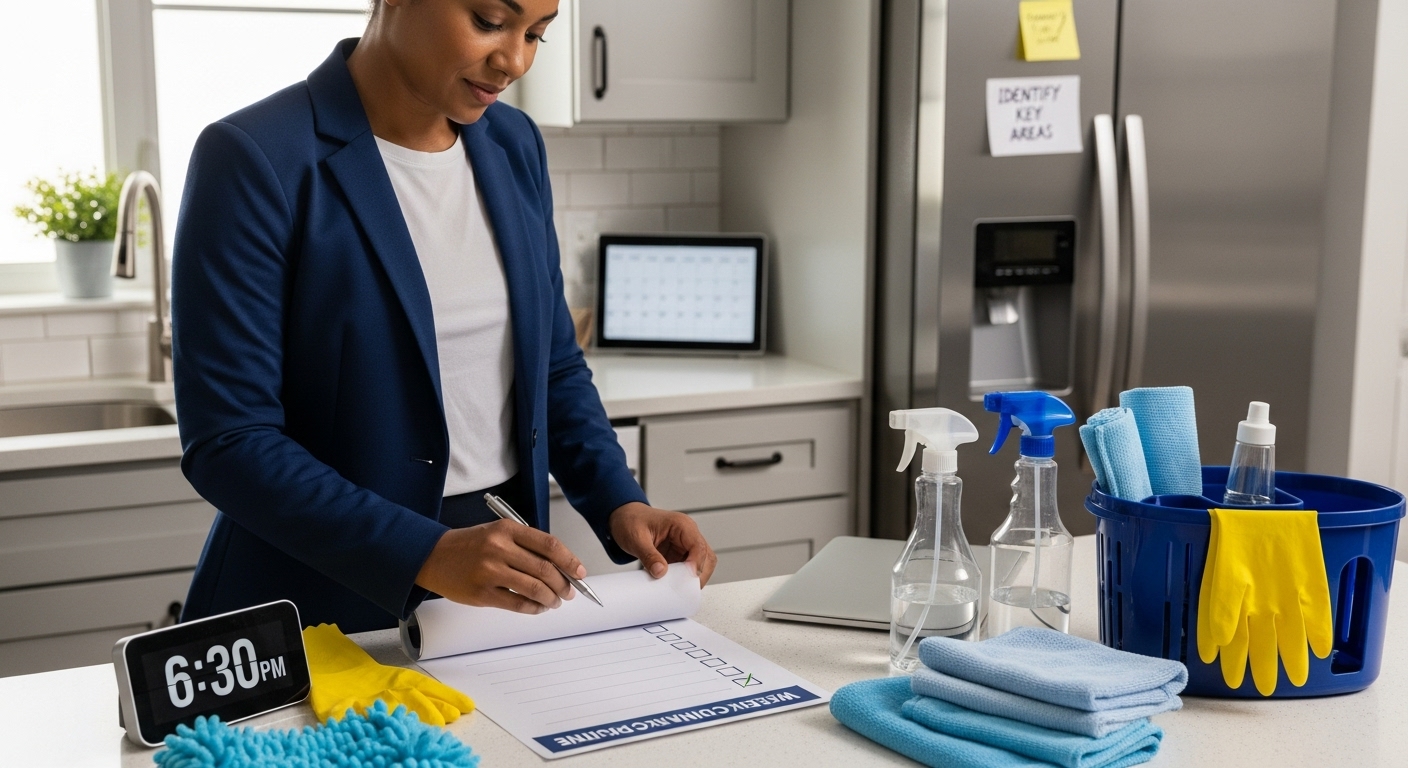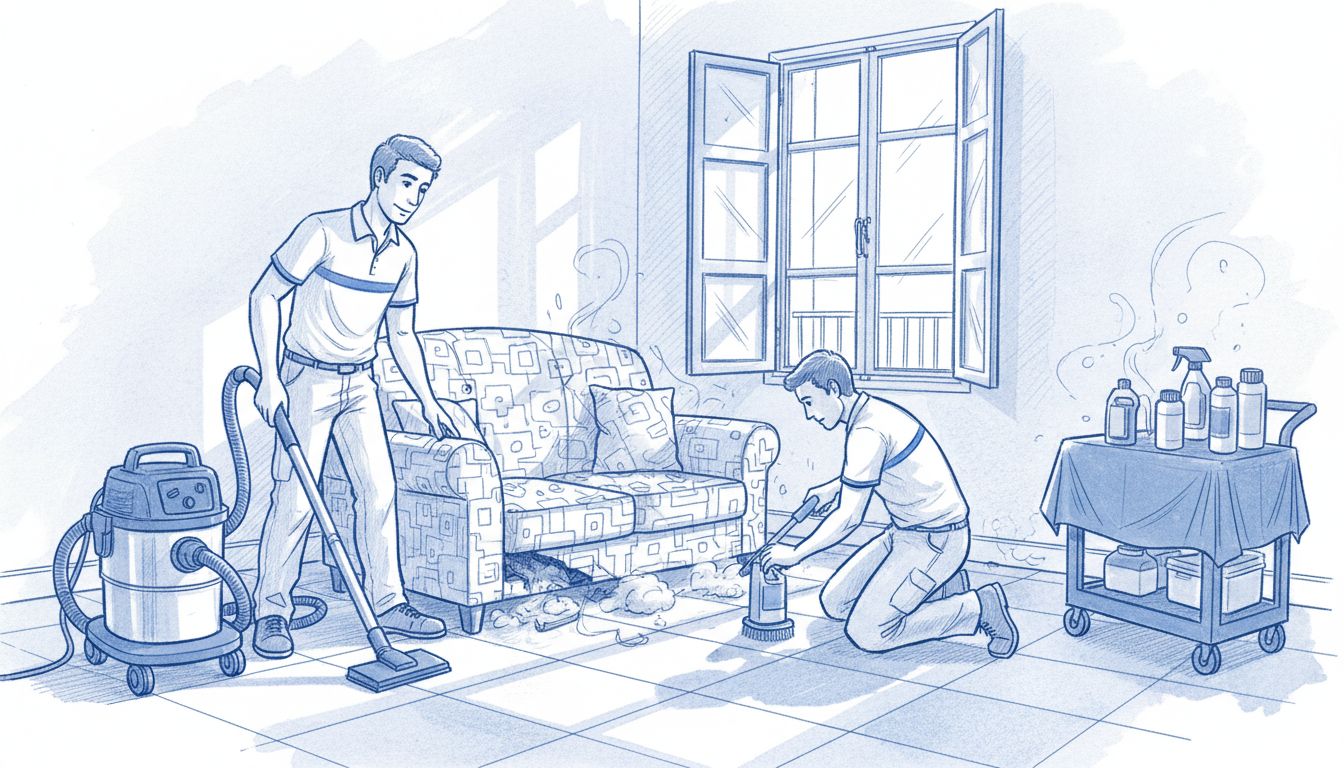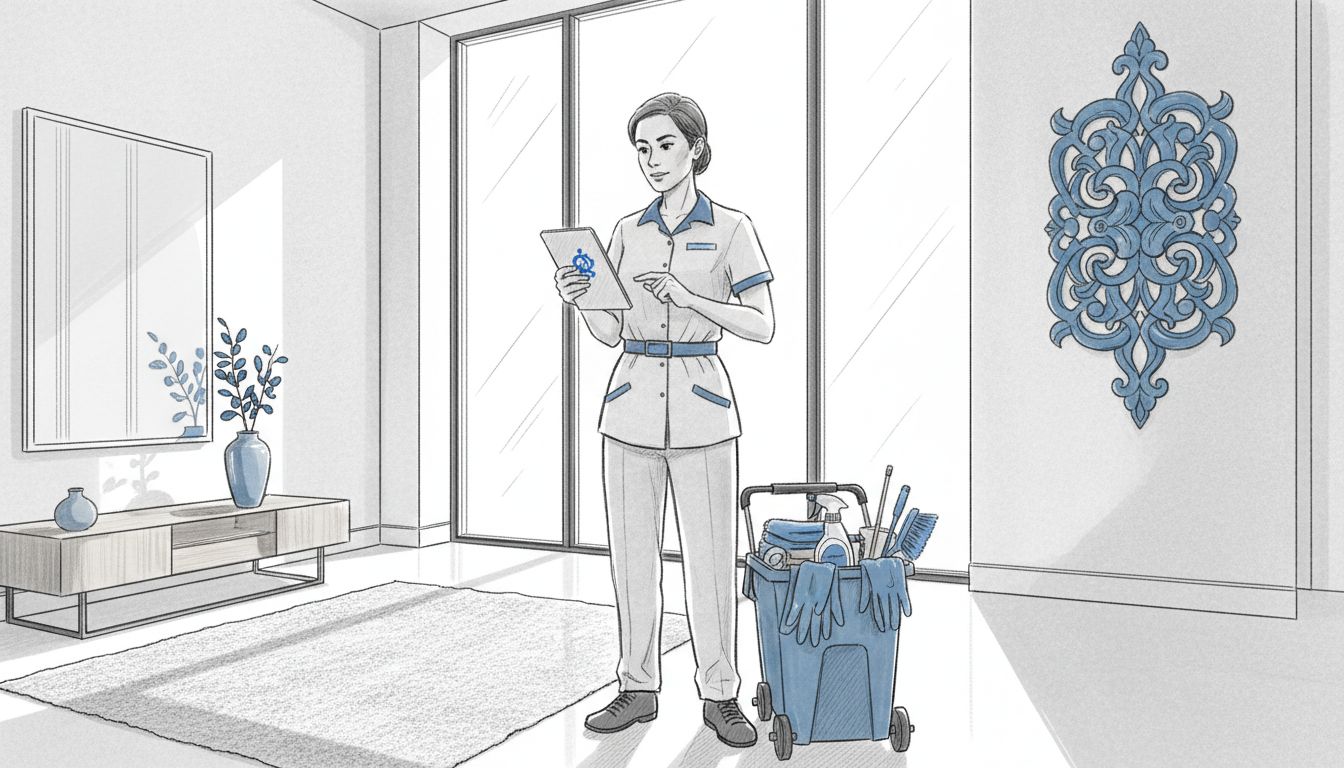Building a weekly cleaning routine sounds simple. Everyone talks about decluttering and sparkling floors, but very few stick to it past week one. The surprise is that living rooms, kitchens, and bathrooms are proven to gather the most bacteria and need the most attention each week. Most people waste time cleaning the wrong spaces or using the wrong supplies—which means a consistent, effective cleaning habit is actually a lot easier to set up than you think.
Table of Contents
- Step 1: Identify Key Areas To Clean Weekly
- Step 2: Gather Necessary Cleaning Supplies
- Step 3: Allocate Time Slots For Each Cleaning Task
- Step 4: Execute Cleaning Tasks Systematically
- Step 5: Review And Adjust Your Routine As Needed
Quick Summary
| Key Point | Explanation |
|---|---|
| 1. Prioritize high-traffic zones for cleaning | Focus on living rooms, kitchens, and bathrooms, as they collect the most dirt and bacteria, requiring regular attention. |
| 2. Assemble a comprehensive cleaning kit | Gather versatile cleaning supplies, including multipurpose cleaners and microfiber cloths, to efficiently tackle various surfaces. |
| 3. Design a flexible cleaning schedule | Allocate specific time slots for cleaning tasks that fit your lifestyle, making it easier to maintain consistency without stress. |
| 4. Follow a systematic cleaning method | Work from top to bottom in each room, ensuring thorough cleaning while minimizing unnecessary movement for greater efficiency. |
| 5. Regularly review and adjust your routine | Reflect on your cleaning strategy monthly to identify what works or needs change based on your evolving situation and needs. |
Step 1: Identify Key Areas to Clean Weekly
Creating an effective weekly cleaning routine starts with strategically identifying the key areas that require regular attention. Not all spaces in your home or workspace accumulate dirt and clutter at the same rate, which means some zones demand more frequent cleaning than others.
Prioritizing High-Traffic Zones
Begin by mapping out the areas that experience the most daily activity. Living rooms, kitchens, and bathrooms typically generate the most dirt and require comprehensive weekly cleaning. According to University of Florida’s Institute of Food and Agricultural Sciences, these spaces harbor the most bacteria and require systematic cleaning approaches.
In your living areas, focus on surfaces that constantly interact with human touch: coffee tables, entertainment centers, remote controls, light switches, and doorknobs. These spots accumulate germs quickly and often get overlooked during quick daily tidying. Your kitchen demands special attention with countertops, appliance exteriors, and food preparation areas needing thorough sanitization. Bathrooms require meticulous cleaning, targeting toilet seats, sink areas, mirrors, and shower spaces.
Systematic Cleaning Assessment
To develop a robust weekly cleaning routine, conduct a systematic assessment of your living or working space. Walk through each room and note areas that collect dust, generate clutter, or show signs of wear. This personal inventory helps you create a customized cleaning strategy that matches your specific environment.
Consider creating a simple tracking system to monitor cleaning progress. This could be a physical checklist or a digital note on your smartphone. Breaking down your cleaning zones into manageable sections prevents overwhelm and ensures no critical area gets neglected. Remember, consistency matters more than perfection. A steady, methodical approach will transform your space more effectively than sporadic, intense cleaning sessions.
By thoughtfully identifying and prioritizing key cleaning areas, you set the foundation for an efficient weekly cleaning routine that maintains a clean, healthy environment with minimal stress and maximum effectiveness.
Step 2: Gather Necessary Cleaning Supplies
Successful weekly cleaning begins with strategic supply preparation. The right tools and cleaning solutions can transform a potentially overwhelming task into a smooth, efficient process. Think of your cleaning supplies as your personal arsenal against dirt and disorder.
Essential Cleaning Kit Preparation
Start by assembling a comprehensive cleaning kit that covers multiple surfaces and scenarios. According to Utah State University’s cleaning recommendations, your core cleaning arsenal should include versatile products that handle various cleaning challenges.
Your basic cleaning kit should feature multipurpose cleaners that work across different surfaces. Invest in quality microfiber cloths, which trap dust and bacteria more effectively than traditional rags. Select cleaning solutions appropriate for specific materials like wood, glass, tile, and stainless steel. Pro tip: Choose concentrated solutions that can be diluted, saving money and reducing plastic waste.
Organize your supplies in a portable caddy or container, grouping similar items together. This approach allows you to move efficiently between rooms without constant trips back to a central storage area. Include protective gear like disposable gloves and consider having separate sets of cleaning tools for different areas of your home to prevent cross-contamination.
Key items to include in your weekly cleaning kit:
- All-purpose surface cleaner
- Glass cleaning solution
- Disinfectant wipes
- Microfiber cloths
- Scrub brushes
- Disposable gloves
- Trash bags
- Paper towels
Before starting your cleaning routine, check your supplies. Replenish any items running low and discard products that are expired or ineffective. Storing your cleaning kit in an easily accessible location encourages consistent maintenance and reduces mental friction when it’s time to clean.
Here is a summary table of essential cleaning supplies and their purposes to help you build a comprehensive weekly cleaning kit.
| Item | Purpose |
|---|---|
| All-purpose cleaner | Cleans and sanitizes most surfaces |
| Glass cleaner | Leaves windows and mirrors streak-free |
| Disinfectant wipes | Kills germs on high-touch areas |
| Microfiber cloths | Traps dust and bacteria effectively |
| Scrub brushes | Removes tough grime from surfaces |
| Disposable gloves | Protects hands from chemicals and germs |
| Trash bags | Collects and disposes of household waste |
| Paper towels | Absorbs spills and dries surfaces |
By methodically gathering and organizing your cleaning supplies, you set the stage for a more streamlined and less stressful weekly cleaning experience. Remember, the right tools not only make cleaning more effective but can also make the entire process more enjoyable.
Step 3: Allocate Time Slots for Each Cleaning Task
Transforming your weekly cleaning routine from a daunting challenge to a manageable process requires strategic time allocation. Effective scheduling turns cleaning from an overwhelming task into a structured, achievable goal. The key is creating a realistic plan that integrates seamlessly with your existing lifestyle and work commitments.
Designing Your Personalized Cleaning Timeline
Begin by analyzing your weekly schedule and identifying pockets of available time. According to North Carolina Cooperative Extension, dedicating specific days to particular tasks can significantly reduce cleaning stress. Consider breaking your cleaning routine into manageable segments that fit around your work, personal commitments, and energy levels.
Most busy professionals find success by allocating shorter, focused cleaning sessions rather than attempting marathon cleaning days. For instance, dedicate 30 minutes after work on specific days to targeted cleaning tasks. Weekday evenings and weekend mornings often provide the most consistent windows for maintaining your living space.
Your ideal cleaning timeline might look like this:
- Monday evening: Quick kitchen deep clean (30 minutes)
- Wednesday after work: Bathroom and living area maintenance (20-25 minutes)
- Friday evening or Saturday morning: Comprehensive home reset (45-60 minutes)
- Sunday afternoon: Laundry and final weekly touchups (30-40 minutes)
Remember that flexibility is crucial. Some weeks might require adjustments based on your work schedule, social commitments, or unexpected events. The goal is creating a framework that feels supportive, not restrictive. Use digital calendar apps or simple smartphone reminders to help track and prompt your cleaning sessions.
The following table outlines a sample weekly cleaning schedule, showing recommended time slots and cleaning tasks to help organize your routine for maximum efficiency.
| Day/Time | Cleaning Task | Estimated Time |
|---|---|---|
| Monday evening | Kitchen deep clean | 30 minutes |
| Wednesday after work | Bathroom & living area maintenance | 20-25 minutes |
| Friday evening/Saturday morning | Comprehensive home reset | 45-60 minutes |
| Sunday afternoon | Laundry & weekly touchups | 30-40 minutes |
Consider your personal energy patterns when scheduling. If you’re more productive in the morning, plan quick cleaning tasks before work. Night owls might prefer evening cleaning sessions. The most effective cleaning schedule is one you can consistently maintain.
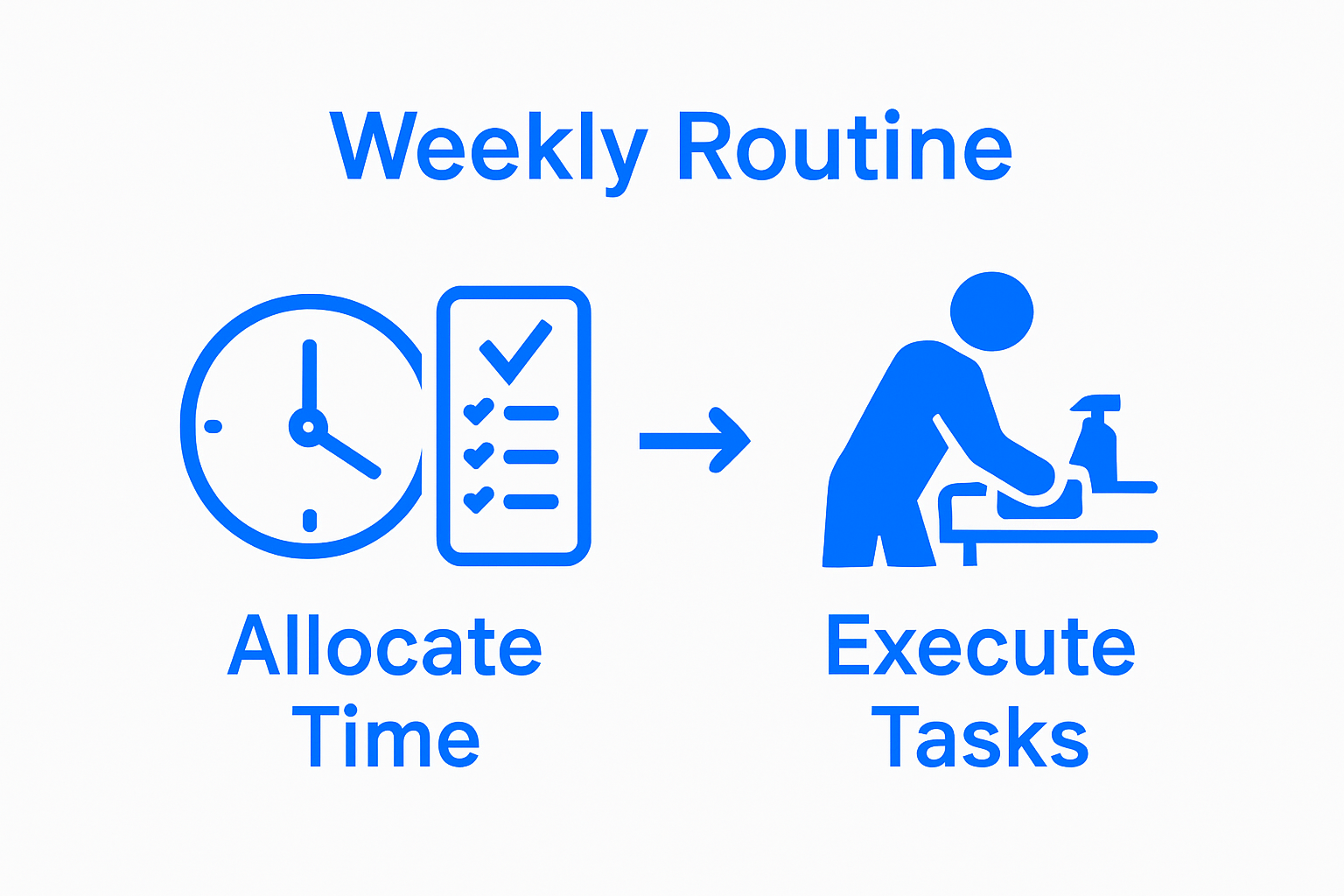
By thoughtfully allocating time slots for each cleaning task, you transform cleaning from a dreaded chore into a structured, manageable part of your weekly routine. The result is a consistently clean living space that requires minimal effort and provides maximum satisfaction.
Step 4: Execute Cleaning Tasks Systematically
Systematic cleaning transforms a chaotic cleaning session into an efficient and thorough process. Developing a strategic approach ensures no area gets overlooked and minimizes time spent cleaning. The goal is to create a methodical workflow that maximizes your cleaning efforts while minimizing unnecessary movement and energy expenditure.
Creating a Top-to-Bottom Cleaning Strategy
Begin your cleaning routine by working from the highest points in each room downward. Start with ceiling corners, light fixtures, and upper shelves, then progress to surfaces, furniture, and finally floors. This top-to-bottom approach ensures that dust and debris naturally fall downward, preventing you from re-cleaning areas you’ve already addressed.
According to PubMed research on cleaning protocols, structured routines significantly improve cleaning efficiency. Implement a consistent pattern in each room: first dust, then wipe surfaces, and finally vacuum or mop floors. Wear clean gloves and use color-coded cleaning cloths to prevent cross-contamination between different areas.
Key systematic cleaning guidelines:
- Always work in the same direction within each room
- Clean from top to bottom in each space
- Use clean cloths for different surface types
- Move items temporarily to clean underneath and behind them
- Allow cleaning solutions sufficient time to break down dirt
Organize your cleaning process by treating each room as a distinct zone. In the kitchen, start with clearing countertops, then clean appliance exteriors, wipe down surfaces, and finish with floors. Bathrooms require a similar approach: mirrors first, then counters, sinks, toilets, and finally floors. Bedrooms and living areas follow the same principle of systematic progression.
Timing is crucial in systematic cleaning. Set a timer for each room to maintain focus and prevent getting bogged down in unnecessary details. Typically, most rooms can be thoroughly cleaned in 15-25 minutes when you follow a consistent pattern. Use microfiber cloths that trap dust effectively and minimize the need for multiple passes over the same surface.
By executing your cleaning tasks systematically, you transform a potentially overwhelming chore into a streamlined, efficient process. The result is a cleaner living space that requires less time and effort, leaving you more energy for the things you truly enjoy.
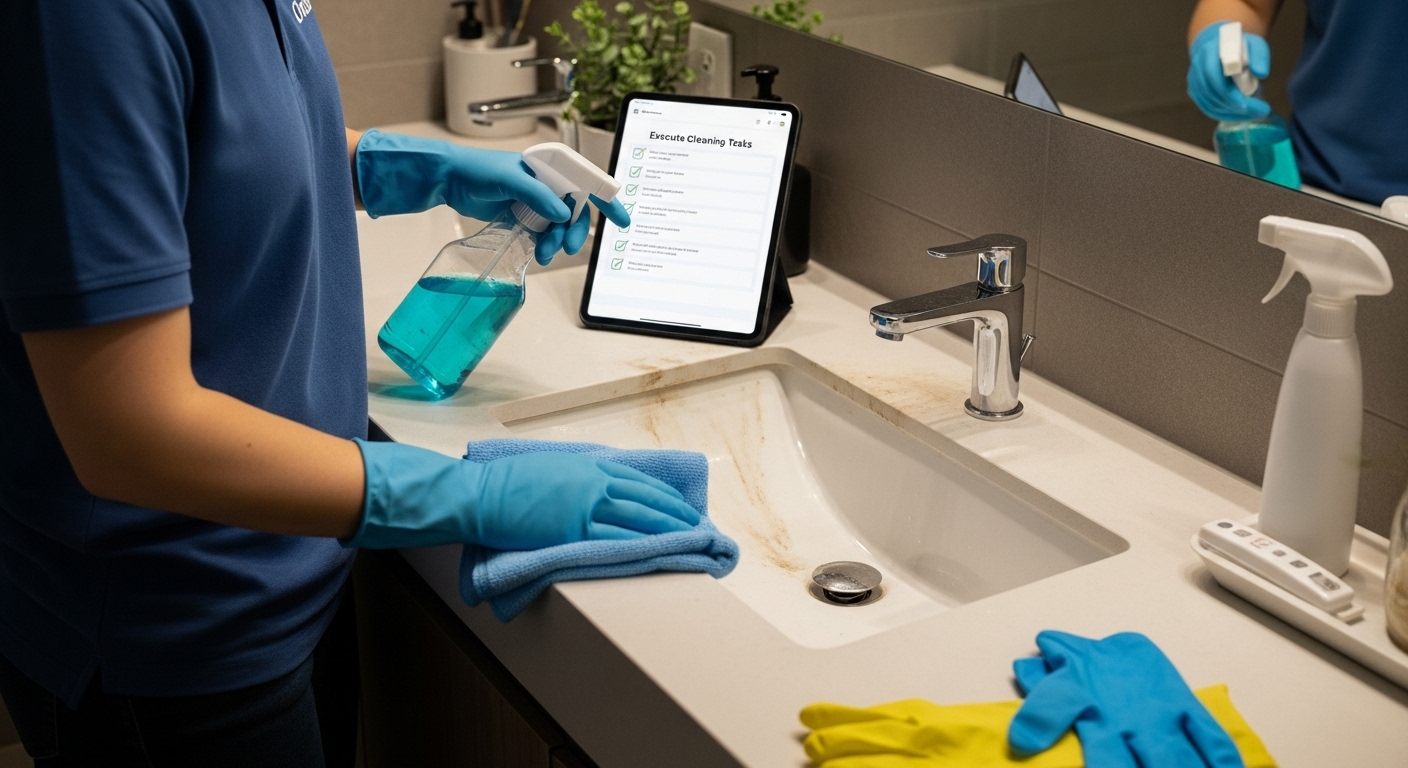
Step 5: Review and Adjust Your Routine as Needed
A truly effective weekly cleaning routine is not static but a dynamic process that evolves with your changing lifestyle and living environment. Flexibility is the secret ingredient to maintaining a sustainable cleaning strategy. What works perfectly this month might need recalibration as your personal and professional circumstances shift.
Start by establishing a monthly review checkpoint where you critically evaluate your current cleaning routine. This intentional pause allows you to assess what’s working, what’s falling short, and where you can optimize your approach. Consider keeping a simple cleaning journal or digital note tracking your observations. Note which tasks take longer than anticipated, which areas consistently need more attention, and any challenges that consistently disrupt your cleaning flow.
According to North Carolina Cooperative Extension, successful cleaning routines require periodic reassessment. Your evaluation should consider multiple dimensions of your cleaning experience:
- Time spent on each cleaning task
- Effectiveness of current cleaning methods
- Physical energy expended
- Areas that consistently remain untidy
- Changes in your living or working environment
- Personal schedule modifications
Pro tip: Be honest with yourself during these reviews. Recognize that perfection is not the goal; consistent improvement is. If a particular cleaning strategy feels like a constant struggle, it’s a clear signal that something needs to change. Perhaps you need to redistribute tasks, invest in more efficient cleaning tools, or adjust your time allocation.
Consider external factors that might necessitate routine adjustments. Seasonal changes, new pets, family dynamics, or work schedule shifts can all impact your cleaning needs. For instance, a home with a new puppy might require more frequent floor cleaning, while a work-from-home professional might need to integrate midday quick cleaning sessions.
Technology can be a valuable ally in routine management. Use smartphone apps or digital calendars to track your cleaning progress, set reminders, and log observations. Some apps even allow you to set recurring tasks and track your cleaning efficiency over time.
Remember, the most successful cleaning routine is one that feels sustainable and integrates smoothly into your life. By committing to regular reviews and willing to make incremental adjustments, you transform cleaning from a dreaded chore into a manageable, even empowering, part of your weekly rhythm.
Take Back Your Evenings With Effortless Cleaning Help
You learned from this article that building a consistent weekly cleaning routine requires time, planning, and reliable follow-through. But most busy professionals still struggle to keep up with demanding work schedules, family commitments, and regular home maintenance. Even with the best intentions, cleaning often slips to the bottom of the to-do list, leaving homes cluttered or feeling chaotic. If your goal is less stress and more free time, there is a better way.

Stop letting your cleaning routine dictate your free time. With Rozie.app, finding a verified cleaner in Malta takes just minutes. Our platform matches you with trusted cleaning professionals, allowing you to delegate your weekly tasks with confidence. All cleaners are carefully vetted for your peace of mind, and our system offers 7 days a week support plus payment protection. Ready to make your weekly cleaning effortless and reclaim your personal time? Book your first visit today at the Rozie.app landing page and see just how simple a clean home can be.
Frequently Asked Questions
What are the key areas to clean weekly in my home?
Focus on high-traffic zones such as the living room, kitchen, and bathroom. These areas harbor more bacteria and require regular cleaning to maintain a hygienic environment.
How can I effectively gather cleaning supplies for my weekly routine?
Assemble a comprehensive cleaning kit that includes multipurpose cleaners, microfiber cloths, disinfectant wipes, and protective gear like disposable gloves. Organizing supplies in a portable caddy can streamline your cleaning process.
How should I allocate time for cleaning tasks during the week?
Analyze your weekly schedule and dedicate specific time slots for cleaning various tasks. Short, focused sessions after work or on weekends can effectively maintain your living space without overwhelming you.
What is the best way to execute cleaning tasks systematically?
Use a top-to-bottom cleaning strategy: start with upper surfaces and progress downward. A structured workflow ensures that dust and debris fall to the floor, preventing the need to re-clean areas you’ve already addressed.

